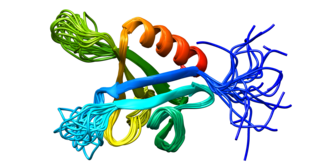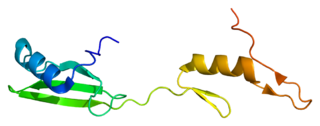Dynamin-1 is a protein that in humans is encoded by the DNM1 gene. [5] [6]
Dynamin-1 is a protein that in humans is encoded by the DNM1 gene. [5] [6]
Dynamin possesses unique mechanochemical properties used to tubulate and sever membranes, and is involved in clathrin-mediated endocytosis and other vesicular trafficking processes. Actin and other cytoskeletal proteins act as binding partners for the dynamin, which can also self-assemble leading to stimulation of GTPase activity. More than sixty highly conserved copies of the 3' region of this gene are found elsewhere in the genome, particularly on chromosomes Y and 15. Alternatively spliced transcript variants encoding different isoforms have been described. [7]
De novo mutations in DNM1 have been associated with a severe form of childhood epilepsy called developmental and epileptic encephalopathy. Most pathogenic variants are missense variants, and have been shown to impair synaptic vesicle endocytosis in a dominant negative manner. [8]
DNM1 has been shown to interact with:

Amphiphysin is a protein that in humans is encoded by the AMPH gene.

Cortactin is a monomeric protein located in the cytoplasm of cells that can be activated by external stimuli to promote polymerization and rearrangement of the actin cytoskeleton, especially the actin cortex around the cellular periphery. It is present in all cell types. When activated, it will recruit Arp2/3 complex proteins to existing actin microfilaments, facilitating and stabilizing nucleation sites for actin branching. Cortactin is important in promoting lamellipodia formation, invadopodia formation, cell migration, and endocytosis.

Tyrosine-protein kinase ITK/TSK also known as interleukin-2-inducible T-cell kinase or simply ITK, is a protein that in humans is encoded by the ITK gene. ITK is a member of the TEC family of kinases and is highly expressed in T cells.

Myc box-dependent-interacting protein 1, also known as Bridging Integrator-1 and Amphiphysin-2 is a protein that in humans is encoded by the BIN1 gene.

Epidermal growth factor receptor substrate 15 is a protein that in humans is encoded by the EPS15 gene.

Dynamin-2 is a protein that in humans is encoded by the DNM2 gene.

AP-2 complex subunit alpha-1 is a protein that in humans is encoded by the AP2A1 gene.

Cytoplasmic protein NCK1 is a protein that in humans is encoded by the NCK1 gene.

Clathrin heavy chain 1 is a protein that in humans is encoded by the CLTC gene.

AP-2 complex subunit alpha-2 is a protein that in humans is encoded by the AP2A2 gene.

Endophilin-A1 is a protein that in humans is encoded by the SH3GL2 gene.

Formin-binding protein 1 is a protein that in humans is encoded by the FNBP1 gene.

Ena/VASP-like protein is a member of the Ena/VASP family of proteins that in humans is encoded by the EVL gene.

Mitogen-activated protein kinase kinase kinase 10 is an enzyme that in humans is encoded by the MAP3K10 gene.

Sorting nexin-9 is a protein that in humans is encoded by the SNX9 gene.

Endophilin-A3 is a protein that in humans is encoded by the SH3GL3 gene.

Endophilin-A2 is a protein that in humans is encoded by the SH3GL1 gene.

Epsin-1 is a protein that in humans is encoded by the EPN1 gene.

Epsin-2 is a protein that in humans is encoded by the EPN2 gene.

Ubiquitin-associated and SH3 domain-containing protein A is a protein that in humans is encoded by the UBASH3A gene.